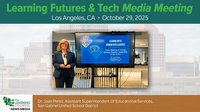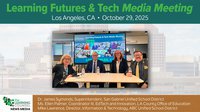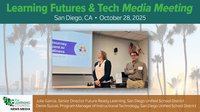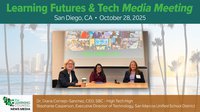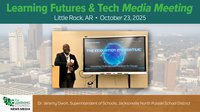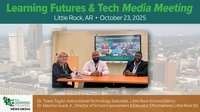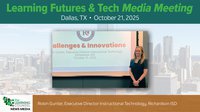AI is in every conversation with K12 leaders and the edtech industry, but it’s not everything, and it may even be a distraction unless it’s positioned alongside the order-bringing framework systems and the crafted and animated paths of knowledge in courseware.
Learning Counsel’s Publisher, LeiLani Cauthen, caught up with Melissa Loble, Chief Academic Officer and Zach Pendleton, Chief Architect at Instructure to have a deep conversation about what’s happening out there in schools and districts with all the digital things.
The first point of discussion was my mentioning that Instructure is in a leadership role to talk about all the things, the thousands of pieces of software and the framework of intentional learning of systems like their own learning management system, Canvas, that schools purchase to solve various aspects of curriculum. All curriculum systems flank others in schools that manage security, certain aspects of remediation, communications, data collection and analysis, assessments, and more. The thing is, Learning Counsel’s research indicates it’s time to winnow, to get more organized, perhaps to do some design thinking and workflow renderings of the pile of things a school has in order to give the human teachers and learners a usable map of it all. Instructure’s trendsetters couldn’t agree more. Their first priority is to bring order and sanity to edtech.
Loble summarized Instructure’s key aims for 2025 are:
- Helping architect the real solution to create personalization with AI.
- Helping schools develop student workforce preparedness skills.
- Helping develop teacher and student AI literacy.
The discussion included my observations of the thousands of comments on Reddit by teachers about the thirty to forty percent of students in every class that are off grade band, with teachers having to manage far more mixed abilities while pushing along a train of lessons moving ever further forward from those students years behind.
“It’s a big part of the burnout, (including) teachers leaving the field altogether after a couple of years because they just don’t know how to manage all that. And it’s not an immediate solution, but I do think this is a good place for AI because some of the personalized curriculum resources can be built for remediation,” said Loble.
“I want that AI model to really capture and extend the teacher voice so that it can be used when the teacher's not there, or it can be used in places in off-hours -- but it is not the 3rd voice in the classroom,” said Pendleton. “Yet there's no large language model today that does that on its own right.
We can speculate about what comes in the future. But right now these models still pretty consistently fall back on their prior training, which means, they may say things that are not true. They may say things that are inappropriate for the audience level. They may say things in a way the teacher would not say them or go off topic. And so when (at Instructure) talk about alignment, it's like, how do we clamp a model's outputs to what a teacher wants it to say, and the way that we've solved that is pretty novel and unique, is taking course content and encoding it or indexing it in the way that a large language model or an AI system would see that content so that when students are interacting with an AI model, whether it's ours or a 3rd party, one, they have access to the right course content at the right time. Anybody can take that prompt, send it to Canvas and get back course content that the instructor has blessed, that is approved, and in the course.”
I commented what a novel new direction this was for Instructure’s Canvas system because consumer AI systems are large languages pointed at everything across the open internet right now, but Instructure is creating a way to narrow band that to control to the school’s and teacher’s domain for students.
“Yeah,” said Pendleton, “but there's a distinction there in in the way that we get that data. You've got content in your pages (in Canvas). You've got video content in studio. You've got lecture captures. You've got assignments. You can train an AI model from that, feed it all of that stuff. That's and I say, when we say training, that’s fine tuning, like sending the model additional information to layer on top of what it has. It captures all that information and makes the right information available, because the other challenge you have with most AI models here is prompt length, right? I can't send the entire world of information and a question to a model at once, because it runs out of context, and it starts to forget things in real time. So (what we are doing at Instructure) allows us to solve a lot of those problems. And I think, you know, the underlying technology may change a little bit as costs change, but the principle is that certainly our system and future systems have got to account for things like prompt length.
Essentially what Pendleton was saying is that they are architecting a way for information surfaced in an AI to have a pedigree worthy of that institution’s curriculum and teaching methods.
Going a step further, Loble said, “What I'm hoping technology companies are doing, what schools are doing, is instead of focusing on just going to implement some AI tools, or just using generative AI, they are asking what are the big problems? What are the different tools in my broader AI toolbox that I can use to address that. How are we thinking about meaningful engagement and activities?”
The conversation stayed on this topic of how a lot of schools continue to purchase single-point solution from the classroom view rather than an enterprise view.
“Districts are coming to expect more from single points,” Loble said. “Now not one solution is going to win at all, but districts are going to expect more even from point solutions. Things we're doing are like centralized identity management is huge. Even if you have a way to log in, it's how are you passing consistently across the tools that you do need information from about a student, how are you protecting a student? How are you getting data back? So this identity piece is a big piece of it. Also a big piece of how district leaders are starting to think is that the identity is embedded for deep learning reporting back on that student from all systems.”
“I think tech and curriculum leaders are thinking they want more than just 8th grade math content or something, they want all math aligned to their curriculum approach. They want to architect the whole thing as opposed to procuring this and that and running around and training everybody on ach of this separate parts. It’s the content and the tech in one, where things are going,” said Loble. “Instructure has already built foundations for that future; we already have it in our platform and it’s an open architecture. We’ve got standards-based integrations and that identity layer, so plumbing-wise, we have already got a head start on pulling AI into that.”
Given my history of helping schools try to build a real working model of all their things during past Learning Counsel events using large Lego blocks and sticky labels, I asked Pendleton to also comment on model architecture, how schools and districts could bring order to their massive software inventory and how it all fits together.
Pendleton said, “Yeah, I'm so glad you mentioned this. So this is something that our research team is working on right now with Amazon web services. I think that when you think about this future where a district that's got 3,000 tools installed, and you're asking instructors to learn some large subset of those, and it's a bunch of different user interfaces and things change every few years, it’s untenable especially when educators are saying, I don't have the time already to do the things you're asking me to do. And I think generative AI is not the end to this, it's not even maybe the best interface, if you just think of it as chat.”
“Natural language Ai can understand what system the thing I want to do lives in it can understand that system's APIs (Application Interfaces), and it can translate my request into those API calls to take
Action on my behalf. So, I think, a potential application of generative AI we’re looking at both inside of Canvas and other systems, is how can we kind of predict what people are going to be doing and adjust the user interface to make that easier for them. With our Amazon project it is a chatbot, but it's a teacher facing thing where the teacher can say what they want to do across an index of Canvas APIs. It's able to map that action into multiple API calls and give the teacher an approval screen to say, ‘Yep, okay. These are the students that I want to grant an assignment extension to. Or this is the message I want to send,’ and then do that on their behalf. Then we're looking at how we would extend that in a framework style to partner tools, too, so that you can have an entire ecosystem that registers themselves through a common interface. Where the teacher doesn't need to know the interface. They just need to know what they want to accomplish,” said Pendleton.
My thanks to Loble and Pendleton for their exciting vision of what the future holds and what Instructure is doing to help lead education in positive directions.
***



